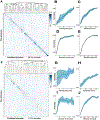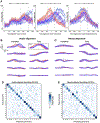Decoding spoken English from intracortical electrode arrays in dorsal precentral gyrus
- PMID: 33236720
- PMCID: PMC8293867
- DOI: 10.1088/1741-2552/abbfef
Decoding spoken English from intracortical electrode arrays in dorsal precentral gyrus
Abstract
Objective: To evaluate the potential of intracortical electrode array signals for brain-computer interfaces (BCIs) to restore lost speech, we measured the performance of decoders trained to discriminate a comprehensive basis set of 39 English phonemes and to synthesize speech sounds via a neural pattern matching method. We decoded neural correlates of spoken-out-loud words in the 'hand knob' area of precentral gyrus, a step toward the eventual goal of decoding attempted speech from ventral speech areas in patients who are unable to speak.
Approach: Neural and audio data were recorded while two BrainGate2 pilot clinical trial participants, each with two chronically-implanted 96-electrode arrays, spoke 420 different words that broadly sampled English phonemes. Phoneme onsets were identified from audio recordings, and their identities were then classified from neural features consisting of each electrode's binned action potential counts or high-frequency local field potential power. Speech synthesis was performed using the 'Brain-to-Speech' pattern matching method. We also examined two potential confounds specific to decoding overt speech: acoustic contamination of neural signals and systematic differences in labeling different phonemes' onset times.
Main results: A linear decoder achieved up to 29.3% classification accuracy (chance = 6%) across 39 phonemes, while an RNN classifier achieved 33.9% accuracy. Parameter sweeps indicated that performance did not saturate when adding more electrodes or more training data, and that accuracy improved when utilizing time-varying structure in the data. Microphonic contamination and phoneme onset differences modestly increased decoding accuracy, but could be mitigated by acoustic artifact subtraction and using a neural speech onset marker, respectively. Speech synthesis achieved r = 0.523 correlation between true and reconstructed audio.
Significance: The ability to decode speech using intracortical electrode array signals from a nontraditional speech area suggests that placing electrode arrays in ventral speech areas is a promising direction for speech BCIs.
Conflict of interest statement
Declaration of interests
The MGH Translational Research Center has a clinical research support agreement with Neuralink, Paradromics, and Synchron, for which L.R.H. provides consultative input. JMH is a consultant for Neuralink Corp and Proteus Biomedical, and serves on the Medical Advisory Board of Enspire DBS. KVS consults for Neuralink Corp. and CTRL-Labs Inc. (part of Facebook Reality Labs) and is on the scientific advisory boards of MIND-X Inc., Inscopix Inc., and Heal Inc. All other authors have no competing interests.
Figures






Similar articles
-
Decoding Speech from Intracortical Multielectrode Arrays in Dorsal "Arm/Hand Areas" of Human Motor Cortex.Annu Int Conf IEEE Eng Med Biol Soc. 2018 Jul;2018:93-97. doi: 10.1109/EMBC.2018.8512199. Annu Int Conf IEEE Eng Med Biol Soc. 2018. PMID: 30440349
-
Decoding articulatory and phonetic components of naturalistic continuous speech from the distributed language network.J Neural Eng. 2023 Aug 14;20(4). doi: 10.1088/1741-2552/ace9fb. J Neural Eng. 2023. PMID: 37487487
-
Effective Phoneme Decoding With Hyperbolic Neural Networks for High-Performance Speech BCIs.IEEE Trans Neural Syst Rehabil Eng. 2024;32:3432-3441. doi: 10.1109/TNSRE.2024.3457313. Epub 2024 Sep 18. IEEE Trans Neural Syst Rehabil Eng. 2024. PMID: 39255187
-
Brain-Computer Interface: Applications to Speech Decoding and Synthesis to Augment Communication.Neurotherapeutics. 2022 Jan;19(1):263-273. doi: 10.1007/s13311-022-01190-2. Epub 2022 Jan 31. Neurotherapeutics. 2022. PMID: 35099768 Free PMC article. Review.
-
The Potential for a Speech Brain-Computer Interface Using Chronic Electrocorticography.Neurotherapeutics. 2019 Jan;16(1):144-165. doi: 10.1007/s13311-018-00692-2. Neurotherapeutics. 2019. PMID: 30617653 Free PMC article. Review.
Cited by
-
Generalizable spelling using a speech neuroprosthesis in an individual with severe limb and vocal paralysis.Nat Commun. 2022 Nov 8;13(1):6510. doi: 10.1038/s41467-022-33611-3. Nat Commun. 2022. PMID: 36347863 Free PMC article.
-
Direct speech reconstruction from sensorimotor brain activity with optimized deep learning models.J Neural Eng. 2023 Sep 20;20(5):056010. doi: 10.1088/1741-2552/ace8be. J Neural Eng. 2023. PMID: 37467739 Free PMC article.
-
Encoding of speech modes and loudness in ventral precentral gyrus.bioRxiv [Preprint]. 2025 May 31:2025.05.30.657105. doi: 10.1101/2025.05.30.657105. bioRxiv. 2025. PMID: 40502202 Free PMC article. Preprint.
-
Tapping into the vocal learning and rhythmic synchronization hypothesis.BMC Neurosci. 2024 Nov 6;25(1):63. doi: 10.1186/s12868-024-00863-2. BMC Neurosci. 2024. PMID: 39506690 Free PMC article.
-
Speech motor cortex enables BCI cursor control and click.bioRxiv [Preprint]. 2024 Nov 22:2024.11.12.623096. doi: 10.1101/2024.11.12.623096. bioRxiv. 2024. Update in: J Neural Eng. 2025 May 14;22(3). doi: 10.1088/1741-2552/add0e5. PMID: 39605556 Free PMC article. Updated. Preprint.
References
-
- Abadi Martín, Barham Paul, Chen Jianmin, Chen Zhifeng, Davis Andy, Dean Jeffrey, Devin Matthieu, et al. 2016. “Tensorflow: A System for Large-Scale Machine Learning.” In 12th ${USENIX} Symposium on Operating Systems Design and Implementation ({OSDI}$ 16), 265–83.
-
- Abbott LF, and Dayan P. 1999. “The Effect of Correlated Variability on the Accuracy of a Population Code.” Neural Computation 11 (1): 91–101. - PubMed
-
- Ajiboye A. Bolu, Willett Francis R., Young Daniel R., Memberg William D., Murphy Brian A., Miller Jonathan P., Walter Benjamin L., et al. 2017. “Restoration of Reaching and Grasping Movements through Brain-Controlled Muscle Stimulation in a Person with Tetraplegia: A Proof-of-Concept Demonstration.” The Lancet 389 (10081): 1821–30. - PMC - PubMed
Publication types
MeSH terms
Grants and funding
LinkOut - more resources
Full Text Sources
Other Literature Sources
Medical
